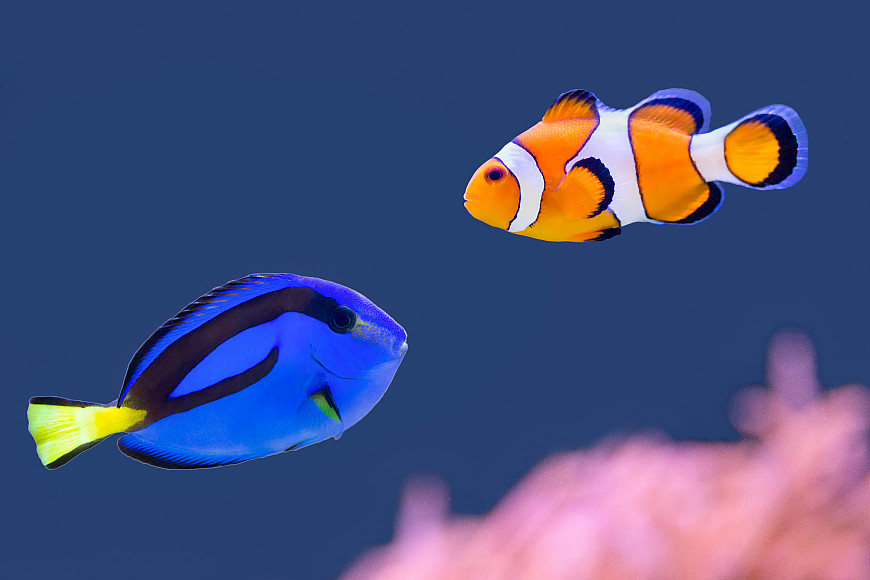The Aquarium Trade Deserves More Scrutiny
Erica Lyman, Clinical Professor and Director of the Global Law Alliance for Animals and the Environment, calls for greater international oversight of the aquarium trade.

Approximately 2.2 million households in America have a saltwater aquarium, and another 11.1 million households keep freshwater fish as pets. The number of fish living in these home aquaria is almost unimaginable. But even harder to imagine is the journey some of these fish took to end up in these tanks.
Many, if not most, of the saltwater fish that enter the United States for the pet trade are imported and taken from the wild. These fish are notoriously difficult to breed and relatively easy to collect with nets, and still sometimes with cyanide poisoning, which is used to stun fish to make them easy to collect but can also kill fish. Cyanide poisoning is illegal in many places, but it is also a challenging law to enforce in places like Indonesia, comprising over 10,000 islands and exporting over 2 billion aquarium fish in a single year. Moreover, according to at least one study, close to 80% of marine fish die in transit, on the way to pet stores and homes.
According to the Center for Biological Diversity, at least 387 million ornamental fish bound for display in home, office, and other aquaria entered the United States over a recent six-year period. While the sheer number is staggering and saddening in and of itself, also troubling is that rarely can the U.S. identify these imports to the species level. This ultimately means that we have no idea how significant an impact this trade is having on species facing conservation risks or the health of certain reef or freshwater ecosystems. We have no idea whether the collection of the species was legal in the first place, which calls into question the applicability of the U.S.’s greatest wildlife law, the Lacey Act.
Some progress is being made in recognition of the simmering crisis for marine ornamental fish in particular. A partnership amongst National Oceanic and Atmospheric Administration (NOAA) Fisheries, Roger Williams University, and others has launched a new database that looks at trade flows. You can use it here to see the quantity of fish from various exporting countries entering the United States.
At least two of the fish in this trade, the Banggai cardinalfish and the zebra placo, are protected under the Convention on International Trade in Endangered Species of Flora and Fauna (CITES). Surely, if we had more species-specific data and more data on the overall conservation status of many more species, CITES would be called on to list several of these fish. In recognition of the important role CITES can play in protecting these precious animals, Parties and stakeholders are engaging in discussions to determine how to collect better data—such science being the key to listing and protecting species in international trade. Hopefully, this leads to concerted action and strengthened international protection long into the future.
As imperfect as international wildlife law may be, it is still clear that there’s room to do so much more with what we have. We urge all CITES stakeholders to work together to collect species-specific data and encourage strong enforcement of laws relating to the collection and harvest of marine fish in countries where enforcement of prohibitions has proved challenging. Without greater oversight and enforcement, fish destined for aquaria will continue to suffer, and the ecosystems from which they are taken will continue to be harmed, all without the public knowing of the damage the aquarium trade is causing.

The Center for Animal Law Studies (CALS) was founded in 2008 with a mission to educate the next generation of animal law advocates and advance animal protection through the law. With vision and bold risk-taking, CALS has since developed into a world-renowned animal law epicenter. CALS’ Alumni-in-Action from over 25 countries are making a difference for animals around the world. CALS is a nonprofit organization funded through donations and grants.
More Center for Animal Law Studies Stories
Center for Animal Law Studies is located in Wood Hall on the Law Campus.
MSC: 51
email cals@lclark.edu
voice 503-768-6960
Center for Animal Law Studies
Lewis & Clark Law School
10101 S. Terwilliger Boulevard MSC 51
Portland OR 97219


